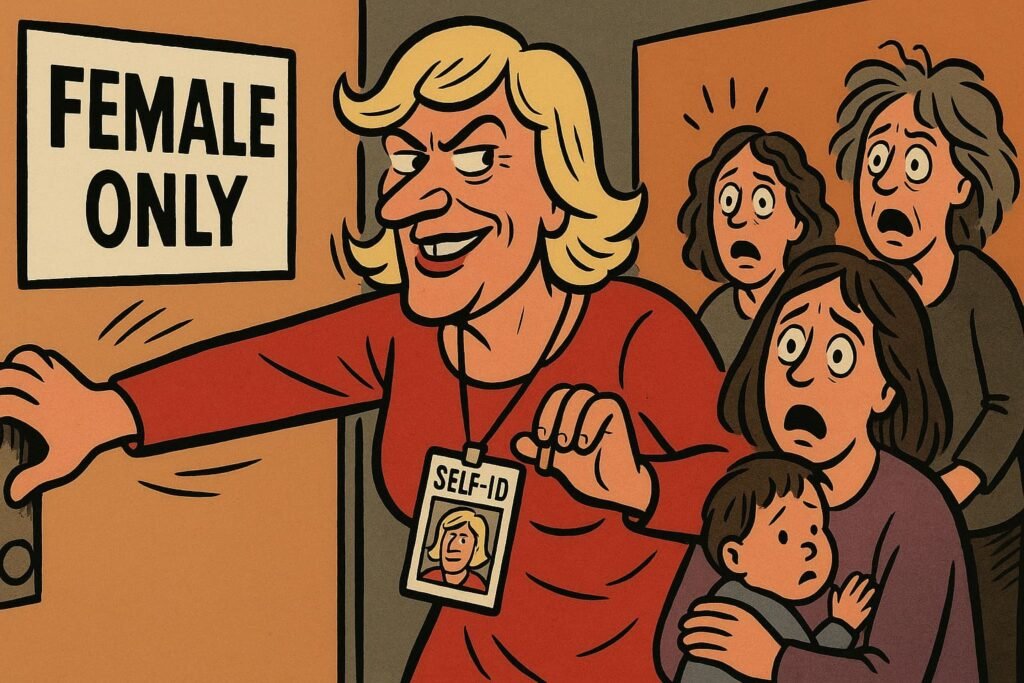Women’s Spaces Explained – Safeguards Built on Biology
From Shelters to Sports Fields
For generations, society recognised that some spaces should be single-sex: shelters, prisons, changing rooms, and sports. The reason wasn’t ideology, but practicality — safety, privacy, and fairness.
Today, that common-sense principle is under attack. Gender self-identification policies are eroding protections for women, allowing biological males into female-only spaces simply by declaring themselves women. The result? Confusion, fear, and in some cases, outright danger.
Table of contents
What Are Women’s Spaces?
Women’s spaces are environments created to ensure safety, dignity, and equal opportunity for women:
- Shelters and refuges: protecting vulnerable women from male violence.
- Prisons: separating inmates for security and safeguarding.
- Changing rooms, bathrooms, and dormitories: safeguarding privacy.
- Sports: ensuring fair competition by separating male and female categories.
They exist not to exclude men, but to protect women. Without them, women lose the right to boundaries.
Why Self-ID Undermines Women’s Spaces
Self-identification policies collapse the distinction between sex and gender. Instead of biological criteria, access is granted based on personal declaration. That means:
- Biological males in female prisons.
- Male-bodied individuals in shelters for battered women.
- Teenage girls forced to undress next to men in school changing rooms.
This isn’t inclusion — it’s erasure.
Real-World Consequences
When policies ignore sex, women pay the price.
- Prisons: In the UK and US, cases emerged where male-born prisoners housed in female facilities committed assaults against women.
- Shelters: Women fleeing abuse have reported being forced to share spaces with male-bodied individuals, undermining the very reason refuges exist.
- Changing rooms: Incidents of voyeurism and harassment have been recorded where males entered female spaces under self-ID rules.
- Children’s safety: Young girls, the most vulnerable, are left confused and unprotected when schools insist they share toilets, dorms, or sports with biological males.
These are not anomalies. They are the predictable outcome of policies that put ideology over reality.
Why Women’s Spaces Still Matter
- Privacy: Women deserve the right to undress, sleep, and heal without male bodies present.
- Safety: Biological males retain physical advantages — in prisons, shelters, and contact sports, that means risk.
- Fairness: In sport, male biology brings enduring advantages in size, strength, and stamina. Self-ID doesn’t erase that.
- Dignity: The promise of women’s spaces was to give women confidence and respect. Without them, that promise is broken.
Why Institutions Cave
- Activists frame objections as “bigotry.”
- Corporations fear backlash and prioritise brand image over women’s safety.
- Politicians see identity issues as easy wins, while avoiding harder reforms.
- NGOs and universities build careers and grants around gender ideology.
Meanwhile, the women who lose most — often poor, vulnerable, or traumatised — have the least voice.
Why It Matters
Women’s spaces are not luxuries. They are protections born of experience. When ideology overrides biology, those protections collapse.
The irony? The very movements that claimed to defend women now dismantle the structures that kept them safe.
Women’s spaces don’t exclude — they safeguard. And if society can no longer say “this space is for women,” then the word woman itself risks losing meaning.
→ Link to Sex in Law (legal clarity), Women’s Rights (core principle), Fairness in Sport (parallel fight for fairness), Feminism (ideological background).
Visit our Women & Biology Explainer Hub to see how law, sport, rights, and safeguarding all collide with ideology.
FAQ: Women’s Spaces
What are women’s spaces?
Areas like shelters, prisons, bathrooms, and sports categories reserved for biological women to ensure safety, privacy, and fairness.
Why are women’s spaces important?
They protect women from male violence, ensure fair competition in sports, and safeguard privacy in intimate settings.
What’s the risk of self-ID policies?
They allow biological males into women-only spaces, creating safety risks, undermining fairness, and eroding trust.
Is this anti-trans?
No. It’s pro-reality. Everyone deserves dignity — but not at the expense of women’s rights and safety.
What happens if women’s spaces vanish?
Women lose privacy, fairness, and protection — and the definition of “woman” itself becomes meaningless.



